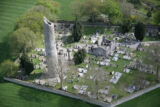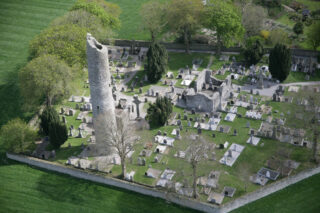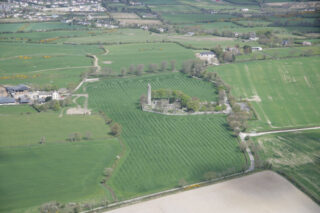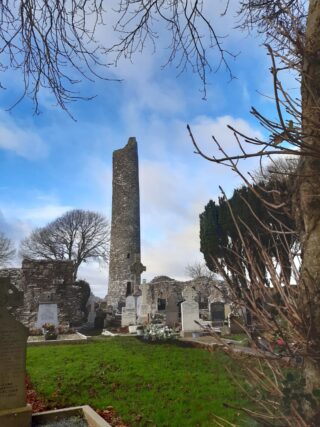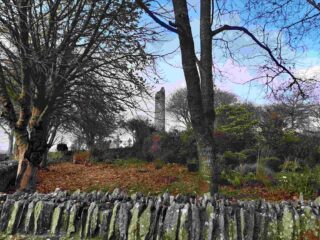Notice
Monasterboice Round Tower and Church is a state-owned National Monument in the care of the Office of Public Works
WARNING: It should be noted that these sites are unguided and a level of care and caution should be maintained during all stages of your visit. The Office Of Public Works (OPW) will not be held responsible for any damages, injuries, or losses that occur
Monasterboice Monastic Site
The monastic settlement of Monasterboice was founded by St. Boetius, an early Irish saint, in the 6th The round tower, is one of the tallest of its kind in Ireland at 30.5m high, even with its conical cap missing. Built of course slabs and blocks of greywacke, with some sandstone, the round tower was a necessary safety feature for all financially thriving monastic settlements, as it was where the riches of the settlement were stored in times of attack from the Irish and Vikings. The monastic settlement was raided and plundered in 968AD by the Vikings. But in 1097AD a fire burned in the round tower, destroying books and many treasures that were held within.
By 1142, with the establishment of Mellifont Abbey nearby, Monasterboice’s importance dwindled.
The north church, construed from the same materials as the round tower, is a simple rectangular building. The ruins show the remains of doorways and four windows. The west doorway has a two-centred arch of chamfered sandstone blocks. The four windows are simple single lights with rebates for movable wooden shutters, 13th century in date. It is believed that this was the church that the head of St. Boetius was housed, which was then stolen in the 16th century.
The south church, older than the north church, was the parish church in medieval times. Built of identical materials as the round tower, it now stands as a ruin. The first phase of this church’s development dates to the 11th century, and is identified as the lintelled west doorway of the rectangular church. The second wave of development was in the 12th century, with new doorways inserted into the north and south walls. The third and final phase of development was in the 15th century, with the south wall rebuilt and windows installed. Inserted into the west wall are four stones with longitudinal grooves, originally from an earlier stone shrine.
The monastic settlement has, arguably, the finest example of a high cross in the county: Muiredach’s Cross, also known as the South Cross. Its similarity to the Cross of the Scriptures at Clonmacnoise suggest that both were carved by the same master mason. At 5.5m tall and complete, it shows carvings of the Old and New Testaments, with a carving of two cats at play on the base of its shaft. It is known as Muiredach’s Cross because of its inscription which translates as asking for ‘a Prayer for Muiredach’; Muiredach was the abbot of Monasterboice and died in 924AD.
The Tall Cross, also known as the West Cross, is the tallest high cross in Ireland, standing to 6.5m. As a result of its height, the number of decorative biblical carvings of the Old and New Testament it carries is also a record.
Visit Historic Environment Viewer for more information on Monasterboice Round Tower & Church
Protect our Past - Click here to read about the importance of protecting our country’s unique heritage sites
This national monument is protected in accordance with the National Monuments Acts 1930 to 2014
Gallery
Nearby sites to visit
Old Mellifont Cistercian Abbey Monastic Site
Visit Ireland’s very first Cistercian foundation
Approx. 5.0 km from Monasterboice Monastic Site
Battle of the Boyne Visitor Centre – Oldbridge Estate
Where two kings fought for Europe’s future
Approx. 6.1 km from Monasterboice Monastic Site
Brú na Bóinne Visitor Centre: Newgrange, Knowth and Dowth
Step into Ireland’s richest archaeological landscape
Approx. 9.6 km from Monasterboice Monastic Site
Hill of Tara
Experience the legacy of the high kings
Approx. 25.5 km from Monasterboice Monastic Site
Carlingford Castle
A Norman citadel in the shadow of a giant
Approx. 33.2 km from Monasterboice Monastic Site
Trim Castle
The ultimate symbol of Norman glory
Approx. 34.9 km from Monasterboice Monastic Site
